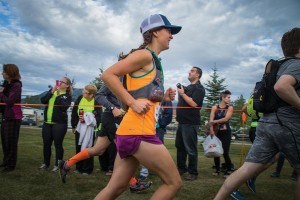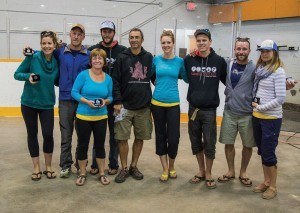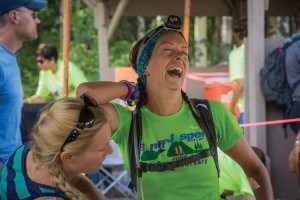
Battling physical exhaustion and mental fatigue, 16 of Jasper’s elite runners tested their endurance during one of the world’s most punishing ultramarathons Aug. 1.
The Canadian Death Race is a gruelling 125-km footrace through the Canadian Rockies that takes competitors up and down mountains, across rivers and streams and through muddy bogs.
The race is broken up into five legs and includes three mountain summits and more than 17,000 feet in elevation change. Historically, only about a third of the solo competitors cross the finish line because of the demanding nature of the race.
In the team category, Jasper took first place in both the men’s and women’s race.
“We were going for a good result,” said Sam LeBlanc, who completed the third leg of the race for the winning men’s team—Four Frenchmen and a Yank.
“We just said, ‘everyone give 100 per cent’ and we’ll go from there.”

The team, made up of LeBlanc, Jocelyn Nadeau, Mike D’Antonio, Bruno Bergeron and Jean-Yves Doucet, finished the race with a time of 11:58:45, about an hour ahead of the second place team.
In a display of pure euphoria and team spirit, all five men joined Bergeron as he crossed the finish line.
“When we knew he was coming in we all waited at the road when he was coming around the corner and made a bridge for him to run under our arms, and then we all ran together with him to the finish line,” said LeBlanc.
The winning women’s team—Valley of the Five Girls—finished with a time of 14:33:37. The team was made up of some of Jasper’s fastest ladies, including Marnie Oatway, Terri Smith, Elsie Todgham, Valerie Bartziokas and Kelsey Thomas.
In the solo category, where competitors complete all five legs of the race themselves, six women represented Jasper.
Wendy Copp was the first solo Jasperite to cross the finish line, placing ninth overall out of 326 competitors with a time of 16:38:52. She also finished second in the female category behind Alissa St. Laurent, from Edmonton, who became the first woman to win the race in its 15-year history.
“You really need to want to finish the race,” said Copp, explaining it’s just as much a mental race as it is physical one.
“Having a good support crew is very important,” she added, noting that this was her first long race as a solo competitor.
For Copp, the key to doing well was breaking the race down into the three major climbs and not over doing it at the beginning.
“You’re trying to conserve your legs a bit on the climbs, especially with the big mountain climbs there’s an element of power hiking.”
Copp said the hardest part of the race for her was during the third leg, just before Mount Hamel, the largest climb of the race.
“Mentally that was the hardest part,” she said, explaining the heat also played a factor.
Copp said she runs at least five days a week anywhere from 15 kms to 50 kms. She also tries to run up Whistlers Mountain at least once a week, and get up Old Man Mountain as often as possible.
“To train for the longer stuff it’s nice to do two back-to-back long runs because it kind of trains your body to run when you are tired,” said Copp.

For Kim Stark, who placed 36th overall with a time of 19:34:23, strategy and proper training was everything.
“Throughout the whole race, and especially at every transition, my strategy was to get in and out as quickly as possible,” said Stark, adding she trained with local ultramarathon runner Tracy Garneau prior to the race.
Stark agreed that the third leg was the most difficult part of the race.
“Mentally the hardest part was leg three, even though it’s not physically as hard, it was really hot and you’ve just come out of leg two, which was physically challenging, and you’re about to start leg four, which is ridiculously challenging, so I think the mental fatigue near the end of leg three was really hard.”
Both women underscored the importance of having a good support crew, eating well and training.
“It sounds strange, but it’s really hard to eat when you’re running that far and you have to make yourself eat, because if you don’t put the fuel in you don’t have the energy,” said Stark.
Of the other solo runners, Lourdes Nunes finished 77th overall with a time of 22:14:16, while Lorraine Wilkinson, Katy Poirier and Garneau each completed stage three, but missed the cut off time to continue the race.
Paul Clarke
[email protected]
